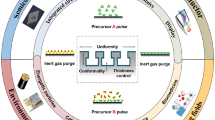Abstract
Defect morphology and distribution up to depths of 20um have been shown to be critical to device performance in micro-electronic applications. A unique and novel x-ray diffraction method called DARC (Digital Automated Rocking Curve) topography has been effectively utilized to map crystalline micro-lattice strains in various substrates and epitaxial films. The spatial resolution of this technique is in the the order of 100um and the analysis time for a 2cm2 area is about 10 secs. DARC topography incorporates state-ofthe- art 1-dimensional and 2-dimensional X-ray detectors to modify a conventional Double Crystal Diffractometer to obtain color x-ray rocking curve topographs.
This technique, being non-destructive and non-intrusive in nature, is an invaluable tool in materials’ quality control for IR detector fabrication. The DARC topographs clearly delineate areas of microplastic strain inhomogeniety. Materials analyzed using this technique include HgMnTe, HgCdTe, BaF2, PbSe, PbS both substrates and epitaxial films. By varying the incident x-ray beam wavelength the depth of penetration can be adjusted from a 1–2 micron up to 15–20um. This can easily be achieved in a synchrotron.
Similar content being viewed by others
References
Guinier, A., “X-ray Diffraction,” W. H. Freeman & Co., 1963 ed., San Francisco.
Weissmann, S., “Recent Advances in X-ray Diffraction Topography,” Fifty Years of Progress in Metallographic Techniques,” Special Technical Publication No. 430.
Ananthanarayanan, T. S., W. E. Mayo and R. G. Rosemeier, “High Resolution Digital X-ray Rocking Curve Topography,” to be published in Volume 30 of Advances of X-ray Analysis.
Ananthanarayanan, T. S., W. E. Mayo, R. G. Rosemeier and R. S. Miller, “Rapid Non-destructive X-ray Characterization of Solid Fuels/Propellants,” to be published in Volume 30 of Advances of X-ray Analysis.
Pangborn, R., Ph.D. Thesis, Rutgers University, 1982.
Rosemeier, R. G., T. S. Ananthanarayanan and W. E. Mayo, “Feasibility Study on Real Time X-ray Topography – Phase I Final Report,” DARPA, September 1984 – February 1985.
Mayo, W. E., R. Yazici, T. Takemoto and S. Weissmann, XII Congress of Int. Union of Crystallography, 1981, Ottawa, Canada.
Mayo, W. E., Ph.D. Thesis, Rutgers University, 1982.
Yazici, R., Ph.D. Thesis, Rutgers University, 1982.
Liu, H. Y., Ph.D. Thesis, Rutgers University, 1982.
Liu, H. Y., W. E. Mayo and S. Weissmann, Mat. Sci. and Eng., 63 (1984) 81.
Qadri, S. B., and J. H. Dinan, J. Appl. Phys. “X-ray Determination of Dislocation Density in Epitaxial ZnCdTe,” p. 1066 (1985).
Ananthanarayanan, T. S., R. G. Rosemeier, W. E. Mayo and S. Sacks, “Novel Non-destructive X-ray Technique for Near Real Time Defect Mapping,” submitted at the 2nd International Symposium on the Nondestructive Characterization of Materials, Montreal, Canada (1986).
Author information
Authors and Affiliations
Rights and permissions
About this article
Cite this article
Ananthanarayanan, T.S., Rosemeier, R.G., Mayo, W.E. et al. Subsurface Micro-Lattice Strain Mapping. MRS Online Proceedings Library 90, 209 (1986). https://doi.org/10.1557/PROC-90-209
Published:
DOI: https://doi.org/10.1557/PROC-90-209




